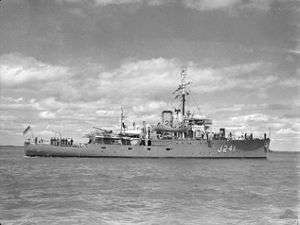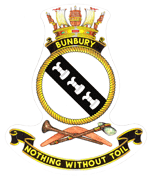HMAS Bunbury (J241)
 HMAS Bunbury in February 1946 | |
| History | |
|---|---|
| Namesake: | City of Bunbury, Western Australia |
| Builder: | Evans Deakin and Company |
| Laid down: | 1 November 1941 |
| Launched: | 16 May 1942 |
| Commissioned: | 3 January 1943 |
| Decommissioned: | 26 August 1946 |
| Honours and awards: |
|
| Fate: | Sold for scrap in 1961 |
| Badge: |
 |
| General characteristics | |
| Class and type: | Template:Sclass-Bathurst |
| Displacement: | 650 tons (standard), 1,025 tons (full war load) |
| Length: | 186 ft (57 m) |
| Beam: | 31 ft (9.4 m) |
| Draught: | 8.5 ft (2.6 m) |
| Propulsion: | triple expansion engine, 2 shafts |
| Speed: | 15 knots (28 km/h; 17 mph) at 1,750 hp |
| Complement: | 85 |
| Armament: | 1 × 4-inch gun, 3 × Oerlikons, Machine guns, Depth charges chutes and throwers |
HMAS Bunbury (J241/M241), named for the city of Bunbury, Western Australia, was one of 60 Bathurst class corvettes constructed during World War II, and one of 36 initially manned and commissioned solely by the Royal Australian Navy (RAN).[1]
Design and construction
In 1938, the Australian Commonwealth Naval Board (ACNB) identified the need for a general purpose 'local defence vessel' capable of both anti-submarine and mine-warfare duties, while easy to construct and operate.[2][3] The vessel was initially envisaged as having a displacement of approximately 500 tons, a speed of at least 10 knots (19 km/h; 12 mph), and a range of 2,000 nautical miles (3,700 km; 2,300 mi)[4] The opportunity to build a prototype in the place of a cancelled Bar-class boom defence vessel saw the proposed design increased to a 680-ton vessel, with a 15.5 knots (28.7 km/h; 17.8 mph) top speed, and a range of 2,850 nautical miles (5,280 km; 3,280 mi), armed with a 4-inch gun, equipped with asdic, and able to fitted with either depth charges or minesweeping equipment depending on the planned operations: although closer in size to a sloop than a local defence vessel, the resulting increased capabilities were accepted due to advantages over British-designed mine warfare and anti-submarine vessels.[2][5] Construction of the prototype HMAS Kangaroo did not go ahead, but the plans were retained.[6] The need for locally built 'all-rounder' vessels at the start of World War II saw the "Australian Minesweepers" (designated as such to hide their anti-submarine capability, but popularly referred to as "corvettes") approved in September 1939, with 60 constructed during the course of the war: 36 (including Bunbury) ordered by the RAN, 20 ordered by the British Admiralty but manned and commissioned as RAN vessels, and 4 for the Royal Indian Navy.[2][7][8][9][1]
Bunbury was laid down by Evans Deakin and Company at Brisbane on 1 November 1941, launched on 16 May 1942 by Mrs. F. A. Cooper, wife of the Treasurer of Queensland, and commissioned on 3 January 1943.
Operational history
The corvette received two battle honours for her service during World War II; "Pacific 1943–45" and "New Guinea 1943–44".[10][11]
Fate
Bunbury paid off to reserve on 26 August 1946 and was sold for scrap to the Kinoshita Company of Japan on 6 January 1961.
Citations
- 1 2 "HMAS Bunbury (I)". HMA Ship Histories. Sea Power Centre – Royal Australian Navy. Retrieved 18 December 2008.
- 1 2 3 Stevens, The Australian Corvettes, p. 1
- ↑ Stevens, A Critical Vulnerability, p. 103
- ↑ Stevens, A Critical Vulnerability, pp. 103–4
- ↑ Stevens, A Critical Vulnerability, pp. 103–5
- ↑ Stevens, A Critical Vulnerability, p. 104
- ↑ Stevens, A Critical Vulnerability, pp. 105, 148
- ↑ Donohue, From Empire Defence to the Long Haul, p. 29
- ↑ Stevens et al., The Royal Australian Navy, p. 108
- ↑ "Navy Marks 109th Birthday With Historic Changes To Battle Honours". Royal Australian Navy. 1 March 2010. Archived from the original on 13 June 2011. Retrieved 23 December 2012.
- ↑ "Royal Australian Navy Ship/Unit Battle Honours" (PDF). Royal Australian Navy. 1 March 2010. Archived from the original (PDF) on 14 June 2011. Retrieved 23 December 2012.
References
- Books
- Donohue, Hector (October 1996). From Empire Defence to the Long Haul: post-war defence policy and its impact on naval force structure planning 1945–1955. Papers in Australian Maritime Affairs. No. 1. Canberra: Sea Power Centre. ISBN 0-642-25907-0. ISSN 1327-5658. OCLC 36817771.
- Stevens, David (2005). A Critical Vulnerability: the impact of the submarine threat on Australia's maritime defense 1915–1954. Papers in Australian Maritime Affairs. No. 15. Canberra: Sea Power Centre Australia. ISBN 0-642-29625-1. ISSN 1327-5658. OCLC 62548623.
- Stevens, David; Sears, Jason; Goldrick, James; Cooper, Alastair; Jones, Peter; Spurling, Kathryn (2001). Stevens, David, ed. The Royal Australian Navy. The Australian Centenary History of Defence (vol III). South Melbourne, VIC: Oxford University Press. ISBN 0-19-554116-2. OCLC 50418095.
- Journal and news articles
- Stevens, David (May 2010). "The Australian Corvettes" (PDF). Hindsight (Semaphore). Sea Power Centre – Australia. 2010 (05). Retrieved 13 August 2010.
External links
| Wikimedia Commons has media related to HMAS Bunbury (ship, 1943). |